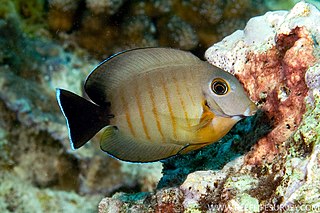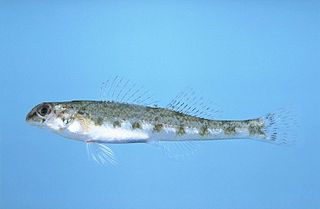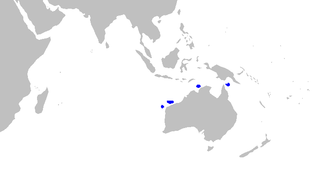 W
WAcanthurus tristis is a tang from the Indian Ocean. It occasionally makes its way into the aquarium trade. It grows to a size of 25 cm in length.
 W
WThe American halfbeak, also known as Meek's halfbeak, is a halfbeak from the family Hemiramphidae.
 W
WThe banded sand catshark is a catshark of the family Scyliorhinidae found in the Indo-West Pacific Ocean, endemic to northern Australia between latitudes 10° S and 21° S, at depths between 27 and 120 metres. Its length is up to 45 centimetres (18 in).
 W
WThe blurred lanternshark is a little-known species of dogfish shark in the family Etmopteridae, found around the world in benthic and pelagic habitats from a depth of 110 m (360 ft) to over 1 km (0.62 mi) down. This shark forms the E. pusillus species group with the smooth lanternshark, which are distinguished from other members of its family by having irregularly arranged, flat-topped dermal denticles that give them a "smooth" appearance. Both species are slender-bodied with long heads, two dorsal fins bearing spines, no anal fins, and light-emitting photophores. The blurred lanternshark is larger, reaching 67 cm (26 in) or more in length. This species feeds on small squid, fishes, and fish eggs, and is ovoviviparous. It has been assessed as of Least Concern by the International Union for Conservation of Nature, because of its wide distribution and lack of threat from fishing pressure.
 W
WCallionymus izuensis, the Izu dragonet, is a species of dragonet which is endemic to the waters around the Izu Islands of Japan. It is found at depths of 16–18 metres (52–59 ft) over substrates consisting of coarse sand, although sometimes coral rubble and broken shells may form part of the habitat. It was originally described as a subspecies of Callionymus persicus from the western Indian Ocean and has also been placed in the genus Calliurichthys by some authorities.
 W
WThe coastal darter is a species of freshwater ray-finned fish, a darter from the subfamily Etheostomatinae, part of the family Percidae, which also contains the perches, ruffes and pikeperches. It is endemic to the eastern United States, where it occurs in the Gulf Coastal Plain from the Choctawhatchee River to the Perdido River in Alabama and Florida. It inhabits sand and gravel bottomed pools of headwaters, creeks, and small rivers.
 W
WThe deepwater sicklefin houndshark or the darksnout houndshark, is a houndshark of the family Triakidae. It is found in the western central Pacific, in the Coral Sea off Queensland and in the waters off New Caledonia.
 W
WDidogobius schlieweni is a species of goby native to the Adriatic Sea. The specific name honours the German ichthyologist Ulrich Schliewen of the Zoologische Staatssammlung München in Munich, the collector of the type and who suggested that the species be given the common name Andromeda Goby referring to the "nebula-like pattern of light and dark markings".
 W
WEtheostoma etowahae, the Etowah darter, is a species of freshwater ray-finned fish, a darter from the subfamily Etheostomatinae, part of the family Percidae, which also contains the perches, ruffes and pikeperches. It is a rare species which is endemic to Georgia in the United States, where it occurs only in the Etowah River and two of its tributaries. It is a federally listed endangered species of the United States.
 W
WHelcogramma williamsi is a species of triplefin blenny in the genus Helcogramma which is widespread in the western Pacific Ocean. It is found in rocky areas with sandy channels at despth of 1 to 3 metres It was described in 2012 from a type collected from Taiwan. The specific name honours the ichthyologist Jeffrey T. Williams of the Smithsonian Institution.
 W
WThe largemouth triplefin, Ucla xenogrammus, is a fish of the family Tripterygiidae and only member of the genus Ucla, found in the Pacific Ocean from Viet Nam, the Philippines, Palau and the Caroline Islands to Papua New Guinea, Australia, and the Solomon Islands, Fiji, Tonga, east to American Samoa and Rapa Iti, at depths of between 2 and 41 metres. Its length is up to about 47 millimetres (1.9 in). The generic name was coined by ichthyologist Richard Heinrich Rosenblatt in his unpublished dissertation of 1959 from the University of California Los Angeles and its is the initials of that institution, it was formally applied by Holleman in 1993.
 W
WOstorhinchus capricornis, also known as the Capricorn cardinalfish, is a species of ray-finned fish, a cardinalfish from the family Apogonidae which occurs around reefs in the western Pacific Ocean.
 W
WPanaqolus maccus, commonly called the clown panaque, clown plecostomus, clown pleco, or ringlet pleco, is a dwarf loricariid. By numbering systems such as the L-number system, this fish may also be known as L104, L162, or LDA22.
 W
WThe Posidonia clingfish is a species of clingfish native to the Australia coast. This species grows to a length of 2 centimetres (0.79 in) SL. Pale green to pale blue with fine spots forming dark reticulations on back and sides, larger blue spots often on back, and a pinkish to brown line from snout to gill cover. The posidonia clingfish is endemic to southern Australia where its range extends from Corner Inlet in Victoria west as far as Rottnest Island in Western Australia. It occurs down to a depth of 10 metres (33 ft) where it is found on macroalgae and within seagrass beds, its favoured substrate to adhere to is the leaves of the sea grass Posidonia australis. This species is the only known member of its genus and was described by John C. Briggs in 1993 with a type locality of Fiddler's Bay which is 16 kilometres south of Tamby Bay in South Australia. Briggs gave the species the specific name hutchinsi in honour of the ichthyologist Barry Hutchins of the Western Australia Museum in Perth, Western Australia.
 W
WRhynchoconger trewavasae is an eel in the family Congridae. It was described by Adam Ben-Tuvia in 1993. It is a marine, deep water-dwelling eel which is known from the western Indian Ocean, including the Gulf of Aqaba, Israel, and possibly the Gulf of Suez. It dwells at a depth range of 300 to 500 metres, and swims in a zigzag motion near the bottom. Males can reach a maximum total length of 57 centimetres (22 in), but more commonly reach a TL of 45 centimetres (18 in).
 W
WSciaenochromis fryeri is a species of cichlid endemic to Lake Malawi where it is found along the rocky coastal areas at depths of from 10 to 40 metres. It can reach a length of 11.5 centimetres (4.5 in) SL. The specific name honours Geoffrey Fryer (b.1927) who was Fisheries Research Officer, Joint Fisheries Research Organisation of Northern Rhodesia and Nyasaland.
 W
WSerrasalmus neveriensis is a species of serrasalmid found in South America in the Coastal rivers of Venezuela.
 W
WThe sicklefin houndshark is a rare houndshark of the family Triakidae, endemic to Western Australia. The holotype was collected from a depth of 150 metres (490 ft) Its reproduction is ovoviviparous.
 W
WThe slender sawtail catshark is a little-known species of catshark, part of the family Scyliorhinidae, endemic to northern Australia. It is found over the continental slope in 290–470 m (950–1,540 ft) on water. Growing to 34 cm (13 in) long, this shark has a slim gray body with four dark saddle markings below the dorsal fins and on the caudal fin, as well as a prominent crest of enlarged dermal denticles along the dorsal edge of the caudal fin. The slender sawtail catshark is not valued by fisheries but is taken as bycatch. The International Union for Conservation of Nature (IUCN) presently lacks enough information to assess its conservation status.
 W
WThe spring pygmy sunfish, Elassoma alabamae, is a species of pygmy sunfish endemic to springs in northern Alabama. It was historically known to occur in springs in North Alabama along the Tennessee River in Limestone and Lauderdale counties. The spring pygmy sunfish was first discovered in Cave Spring in Lauderdale County, Alabama in 1937 but in 1938, this site was flooded by the creation of the Pickwick Reservoir. The spring pygmy sunfish was considered extinct until its rediscovery in the Beaverdam Spring complex in 1973 by researchers from the University of Tennessee.
 W
WThe Zebra acara is a species of cichlid from Rio Uaupes and Rio Preto, two side rivers of Rio Negro in Brazil. This species can reach a length of 10 centimetres (3.9 in) TL. This species prefers a pH between 4.5 and 6.0, and a temperature between 22 and 28 °C.